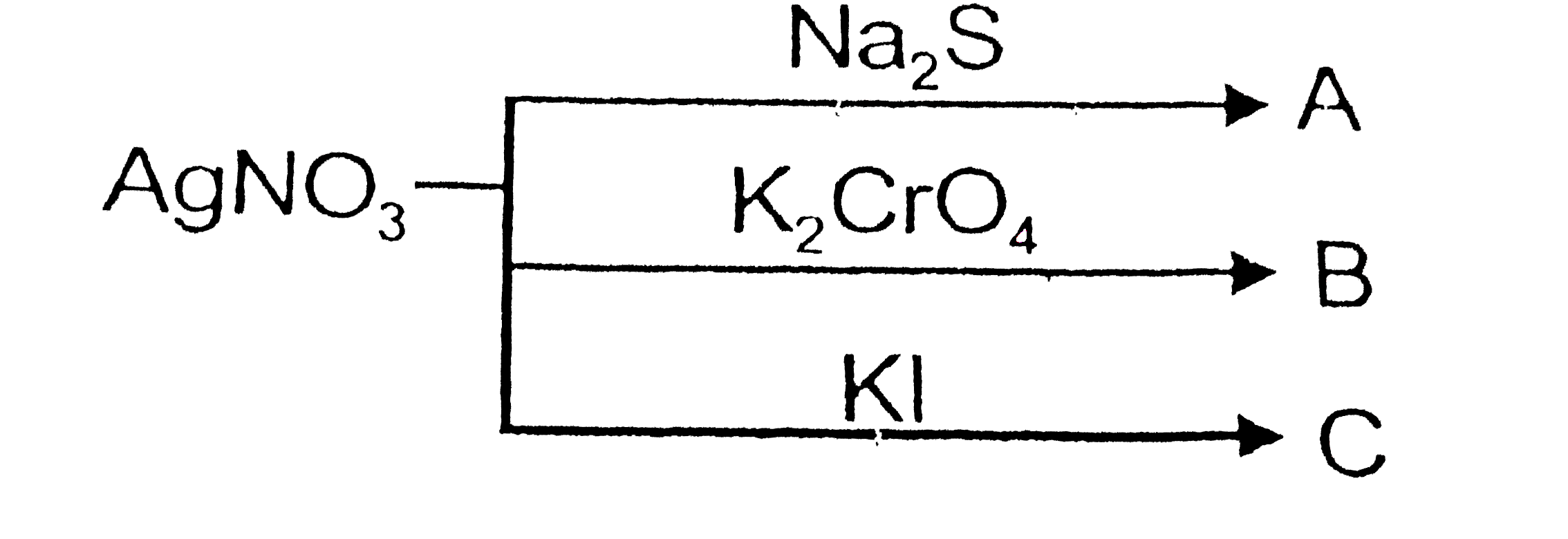
The colours of ppt. A,B and C respectively are
Black , yellow , deep yellow
Black , red , yellow
Brown, red , white
Black , white , red
The correct Answer is:B
Step by step video & image solution for The colours of ppt. A,B and C respectively are by Chemistry experts to help you in doubts & scoring excellent marks in Class 12 exams.
Updated on:21/07/2023Topper's Solved these Questions
- THE D AND F-BLOCK ELEMENTS BOOK - AAKASH INSTITUTECHAPTER - THE D AND F-BLOCK ELEMENTS EXERCISE - Assingnment(Section -C ( Objective Type Questions)(More tha one option is correct))
11 Videos
- THE D AND F-BLOCK ELEMENTS BOOK - AAKASH INSTITUTECHAPTER - THE D AND F-BLOCK ELEMENTS EXERCISE - Assingment ( Section-D Linked Comprehension Type Questions ) Comprehension-I
3 Videos
- THE D AND F-BLOCK ELEMENTS BOOK - AAKASH INSTITUTECHAPTER - THE D AND F-BLOCK ELEMENTS EXERCISE - Assingnment(Section -A ( Objective Type Questions)(One option is correct))
50 Videos
- Test-12BOOK - AAKASH INSTITUTECHAPTER - Test-12EXERCISE - Exercise
30 Videos
- THE P-BLOCK ELEMENTSBOOK - AAKASH INSTITUTECHAPTER - THE P-BLOCK ELEMENTSEXERCISE - Assignment Section-J)
16 Videos
Similar Questions
(i)A blue coloured compound (A) on heating gives two product (B) & (C).
(ii)A metal (D) is deposited on passing hydrogen through heated (B).
(iii)The solution of (B) in HCl on treatment with the [Fe(CN)6]4− gives a chocolate brown coloured precipitate of compound (E).
(iv)(C) turns lime water milky which disappears on continuous passage of (C) forming a compound (F).
Identigfy (A) to (F) and give chemical equations for the reactions at step (i) to (iv).
View SolutionChoose the most appropriate options.
Compound A undergoes following reaction to form B and C .
Black coloured solid (A) KNO3+KOH−−−−−−−−→
Green coloured solid B CO2→ Pink solution + A
(C ) decolorised by Fe+
Identify A,B and C respectively
View Solution
Knowledge Check
Three persons A, B and C wore shirts of black, blue and orange colours (not necessarily in that order) and pants of green, yellow and orange colours (not necessarily in that order). No person wore pant and shirt of the same colour. Further, it is given that
(i) A did not wear shirt of black colour. UFA
(ii) B did not wear shirt of blue colour.
(iii) C did not wear shirt of orange colour.
(iv) A did not wear pant of green colour.
(v) B wore pant of orange colour.
What were the colours of pant and shirt worn by C, respectively ?AYellow and BlackBYellow and BlueCGreen and BlueDOrange and BlackConsider the following reaction,
H2C=CH2+Br2BA−−→BrCH2CH2BrC
The reactant 'A' and colour of 'B' and 'C' are respectivelyAA→CCl4B→colourless C→reddish brownBA→CCl4B→reddish brownC rarr colourlessCA→CBr4 B → colourless C → reddish brownDA→CBr4 B → reddish brown C → colourlessThree test tubes, A,B,C, contain Pb2+,Hg2+2 and Ag+ ( but unknown ) . To each aqueous solution, NaOH is added is excess . Following changes occur.
A: Black p p t, B: Brown ppt ,C: White ppt but dssolves in excess of NaOH
A,B and C contain respectively.APb2+,Hg2+2,Ag+BHg2+2,Ag+,Pb2+CAg+,Pb2+,Hg2+DAg+,H2+2,Pb2+2
A metal gives two chlorides A and B. A give black ppt with NH3 and B gives white. With KI, B gives a yellow ppt, which is soluble in excess of KI. A and B are respectively
View SolutionA metal gives two chlorides 'A' and 'B'.'A' gives black precipitate with NH4OH and 'B' gives white ppt. With KI 'B' gives a red precipitate soluble in excess of KI.'A' and 'B' are respectively :
View SolutionWhen CuSO4 solution is treated with NH4OH, a green ppt, is first formed which dissolves in exces of the reagent to give deep blue colouration. The green ppt, and deep blue coloured compound are, respectively.
View SolutionNH3 solution was added to four semple solution in difference test tube and found the following observation about the precipitate.
a. White ppt which is solution in oxcess of NH3 solution
b.On heating which is white in cold but yellow on heating
c. The cation present in (b) forms white ppt , with hypo solution which give black ppt on heating
d. The cation present in (c ) forms soluble complex with excess of NH3 solution
White ppts in (a),(b) and (c ) respectively obtained are
View Solution(i)A blue coloured compound (A) on heating gives two product (B) & (C).
(ii)A metal (D) is deposited on passing hydrogen through heated (B).
(iii)The solution of (B) in HCl on treatment with the [Fe(CN)6]4− gives a chocolate brown coloured precipitate of compound (E).
(iv)(C) turns lime water milky which disappears on continuous passage of (C) forming a compound (F).
Identigfy (A) to (F) and give chemical equations for the reactions at step (i) to (iv).
View Solution
